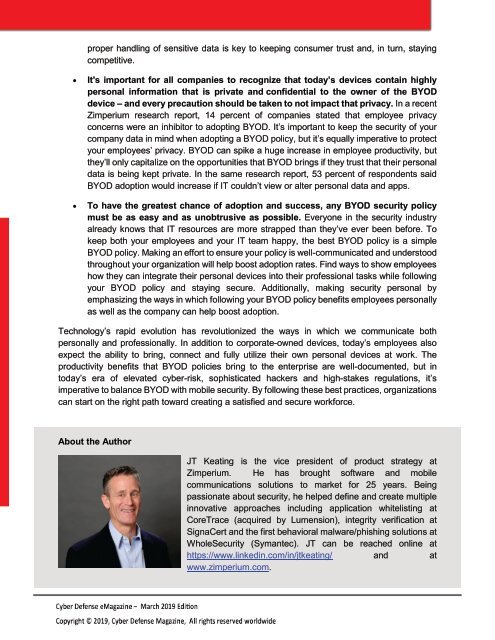Cyber Defense eMagazine - March Edition 2019
Cyber Defense Magazine - March Edition 2019. This is a 157 page emagazine. Cyber Defense Magazine is published monthly. Loaded with free OSINT (open source intelligence) and INFOSEC (Information security) best practices all about cyber security and defense.
Cyber Defense Magazine - March Edition 2019. This is a 157 page emagazine. Cyber Defense Magazine is published monthly. Loaded with free OSINT (open source intelligence) and INFOSEC (Information security) best practices all about cyber security and defense.
You also want an ePaper? Increase the reach of your titles
YUMPU automatically turns print PDFs into web optimized ePapers that Google loves.
proper handling of sensitive data is key to keeping consumer trust and, in turn, staying<br />
competitive.<br />
• It's important for all companies to recognize that today’s devices contain highly<br />
personal information that is private and confidential to the owner of the BYOD<br />
device – and every precaution should be taken to not impact that privacy. In a recent<br />
Zimperium research report, 14 percent of companies stated that employee privacy<br />
concerns were an inhibitor to adopting BYOD. It’s important to keep the security of your<br />
company data in mind when adopting a BYOD policy, but it’s equally imperative to protect<br />
your employees’ privacy. BYOD can spike a huge increase in employee productivity, but<br />
they’ll only capitalize on the opportunities that BYOD brings if they trust that their personal<br />
data is being kept private. In the same research report, 53 percent of respondents said<br />
BYOD adoption would increase if IT couldn’t view or alter personal data and apps.<br />
• To have the greatest chance of adoption and success, any BYOD security policy<br />
must be as easy and as unobtrusive as possible. Everyone in the security industry<br />
already knows that IT resources are more strapped than they’ve ever been before. To<br />
keep both your employees and your IT team happy, the best BYOD policy is a simple<br />
BYOD policy. Making an effort to ensure your policy is well-communicated and understood<br />
throughout your organization will help boost adoption rates. Find ways to show employees<br />
how they can integrate their personal devices into their professional tasks while following<br />
your BYOD policy and staying secure. Additionally, making security personal by<br />
emphasizing the ways in which following your BYOD policy benefits employees personally<br />
as well as the company can help boost adoption.<br />
Technology’s rapid evolution has revolutionized the ways in which we communicate both<br />
personally and professionally. In addition to corporate-owned devices, today’s employees also<br />
expect the ability to bring, connect and fully utilize their own personal devices at work. The<br />
productivity benefits that BYOD policies bring to the enterprise are well-documented, but in<br />
today’s era of elevated cyber-risk, sophisticated hackers and high-stakes regulations, it’s<br />
imperative to balance BYOD with mobile security. By following these best practices, organizations<br />
can start on the right path toward creating a satisfied and secure workforce.<br />
About the Author<br />
JT Keating is the vice president of product strategy at<br />
Zimperium. He has brought software and mobile<br />
communications solutions to market for 25 years. Being<br />
passionate about security, he helped define and create multiple<br />
innovative approaches including application whitelisting at<br />
CoreTrace (acquired by Lumension), integrity verification at<br />
SignaCert and the first behavioral malware/phishing solutions at<br />
WholeSecurity (Symantec). JT can be reached online at<br />
https://www.linkedin.com/in/jtkeating/ and at<br />
www.zimperium.com.


















